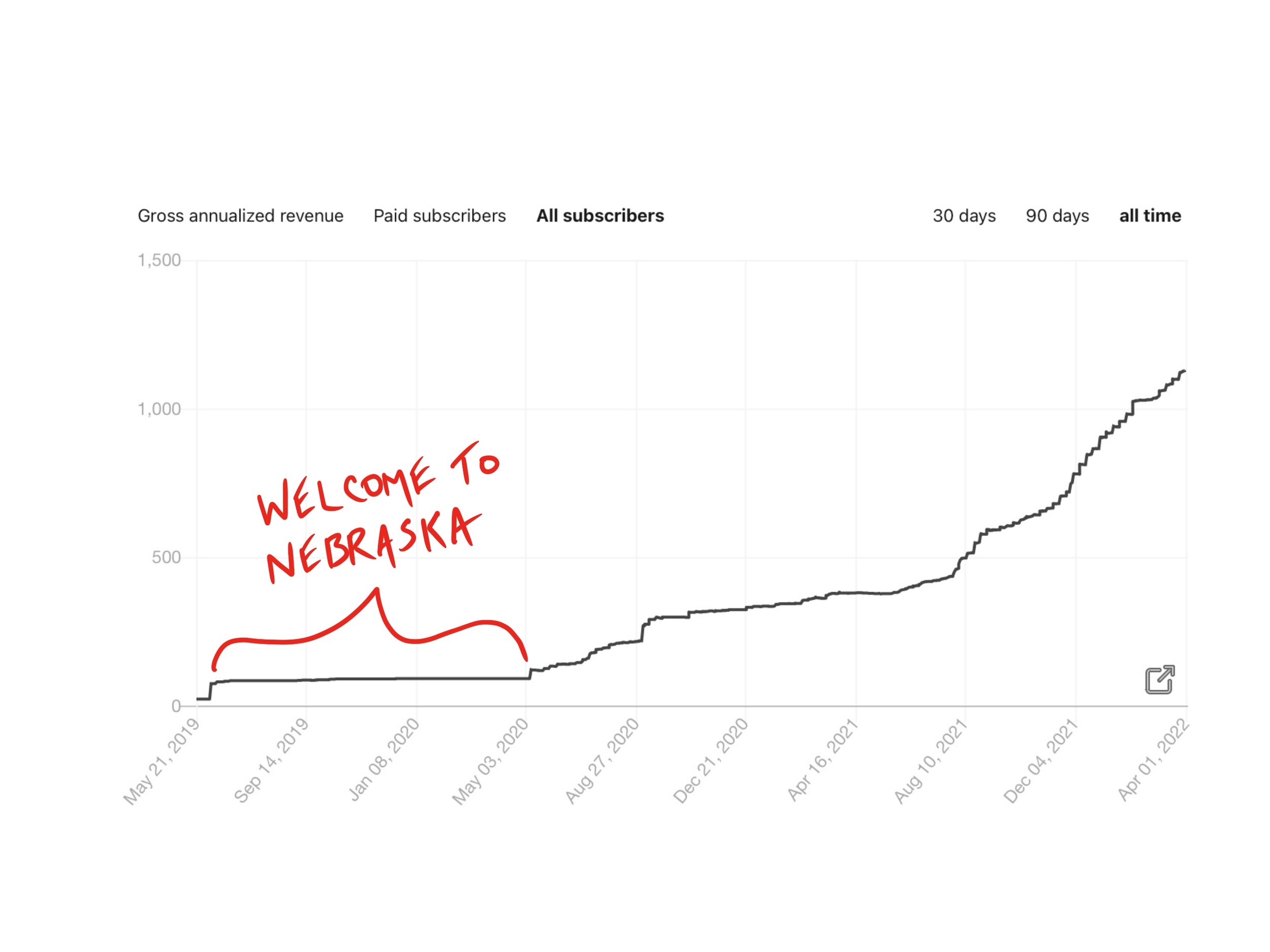Six lessons learned writing 137 newsletters
In May of 2019 I published my first newsletter. It was called “Writing Matters.”
The content sucked as much as the title.
Today, Matt’s Mix Tape helps middle-aged people use fitness and writing to remix and recreate their lives.
One-hundred and thirty-six editions later, here are six lessons learned.
First lesson: let it suck for awhile
My first newsletter sort of apologized for existing. It didn’t know what it was, or where it was going.
The audience was small. And that was good, because we only improve by publishing. And a small and loyal audience will stick with you as your newsletter evolves and improve.
Second lesson: Slow growth is good
For the first year of publishing, I added no new subscribers. I personally invited 50 or 60 people to my list and then nothing changed. My growth curve was Nebraska-flat:
But that was ok.
I didn’t know what world I was building, as we will talk about in a minute.
I was practicing, learning, improving, and serving a small audience --but most importantly serving myself.
Third lesson: Write for yourself
On the Tim Ferriss podcast, Maria Popova, who writes The Marginalian to millions of readers each week, said:
“Write for yourself. If you want to create something meaningful and fulfilling, something that lasts and speaks to people, the counterintuitive but really, really necessary thing is that you must not write for people.”
--Maria Popova, The Marginalian
Two reasons you must write for yourself:
First, you can’t sustain this journey otherwise. It’s too much work to write every week about things that don’t light you up, things you’re not living out in your own life.
Secondly, enthusiasm and passion are the only thing corporations, copybots and ghostwriters cannot replicate. Not sustainably. Not in the long run.
Writing for yourself is a built-in competitive advantage. People—the right people—will sense your enthusiasm and be drawn in.
But there’s a caveat: Be useful.
Writing for ourselves doesn’t mean we’re selfish, or self-indulgent
We still want to share things that are valuable, interesting, and concise. Austin Kleon nails it with this diagram:
Fourth lesson: If you miss an edition, just start again
In February 2020, I went through a grueling interview process for a job I really wanted.
I’d interviewed with the entire C-suite of this company more than once. They’d sit around a table together, and politely pelt me with question after question.
It was a long and brutal process.
After the last interview, they enthusiastically said they’d get back to me in just a couple of days.
I thought I’d nailed it. We were going to move. My dad had just had quadruple bypass surgery and we would be far closer to him and the rest of my and my wife’s families.
It was all coming together. Or so I thought.
Two weeks later: rejection via email.
The same day, I was turned down for another role I’d interviewed for at another company. And then COVID hit.
I stopped writing.
I didn’t publish for five weeks. I didn’t feel like I had anything more to say. The newsletter felt pointless. And I felt deflated.
But after those five weeks, I started up again.
I didn’t apologize. I didn’t mention the gap at all. No one said a word.
I’ve now published 100 weeks in a row.
No one really cares if you miss. And if they did, what are they writing? Statistically speaking, almost certainly nothing. Their criticisms don’t count.
If you miss, just get back on the horse and ride again. No apologies, no excuses.
Fifth lesson: Individuality emerges over time
When you keep riding that horse, you’ll find your individuality emerges over time. So pay attention to what annoys you about your own newsletter. That’s your growth path.
For example, I was annoyed by this logo:
Boring!
And I couldn’t find anything to replace it.
Then I did this. Even worse. What the hell even is this?
Then, Nate Kadlac taught me to use Procreate. So I started doing my own logo every week:
Then I took Nate’s course, Approachable Design, and learned about color palettes. I started consistently using brown and turquoise as my anchor colors.
Now I have a unique and consistent thing in my newsletter every week.
There is no zero chance I could have planned in advance and said, “You know, I’m going to doodle inside a template of a cassette tape every week.”
Completely unpredictable. No way to plan that.
Let things evolve. And pay attention to what bothers you about your own newsletter. Lean into that annoyance. It lays the path for your own uniqueness--for your own world building.
Final lesson: Build a new world
Maybe you’ll take off like a rocket ship, like Packy McCormick did with Not Boring.
Packy quickly built an audience and sustainable business writing about startups.
I highly suggest you read Packy’s essay on The Great Online Game. Packy talks about newsletters as a world-building tool illustrated through the example of Alex Danco who built Dancoland.
Alex literally drew the world he wanted to create and explore in his newsletter.
If you’re going to grow slowly and deliberately, what kind of world do you want to build?
As for Matt’s Mix Tape, I want to build a world of Gen Xers and Millennials in the best shape of their lives, creating great stuff. Growing and improving in midlife. Not coasting. Not deteriorating. Improving, physically, mentallly, spiritually.
Like my newsletter, I want my audience to gradually improve with time.
I hope your newsletter does, also.






